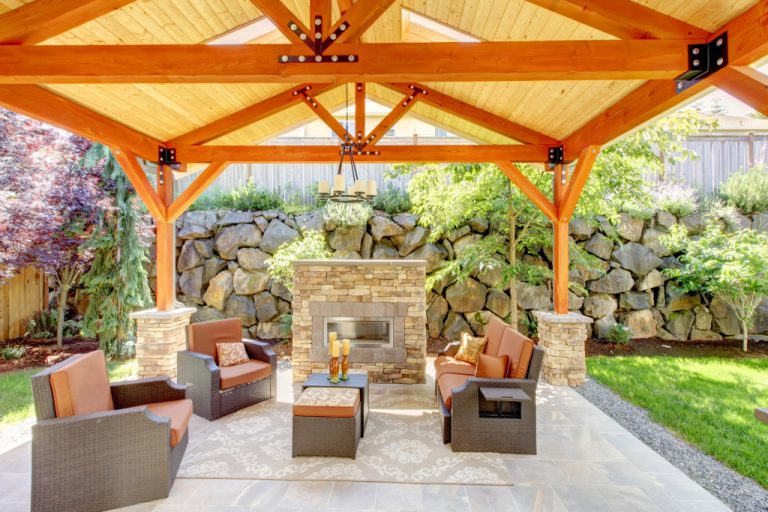One thing that makes the United States such a great country is the large backyards. No matter what city you live in, chances are you have a significantly larger backyard than the average backyard in other countries. This is because Americans value their privacy and space, and they want to be able to enjoy their little piece of nature.
Backyards in the United States vary significantly in size, but the average size is around 10,000 square feet. These yards offer plenty of room for activities like grilling, swimming, and playing games. If you’re lucky enough to have a big backyard, you know how much fun it can be to spend time outdoors with family and friends. There’s nothing quite like relaxing in your backyard on a beautiful summer day.
One way to take the full opportunity is to build your patio. Patios are great for enjoying the outdoors, and they can be used for a variety of activities. For example, you can install a patio cover to provide some shade, or you can set up a few chairs and a table so you can eat outside. If you have children, you can also set up a playset or sandbox in your backyard.
Here are some of the essential steps for your DIY patio.
Purchase the Necessary Materials
The first step into building your patio in your backyard is to purchase the necessary materials. Here’s what you’re going to need and why you need them:
- Concrete mix: You need a concrete mix to create the foundation for your patio. It’s essential to choose a high-quality mix designed for outdoor use.
- Paver stones: Pavers are the individual stones that will make up your patio surface. There are many different types, sizes, and colors of pavers, so take your time exploring your options.
- Landscape fabric: This is a weed barrier that you’ll lay down before installing your pavers. It’s essential to choose a heavy-duty fabric that will last for years.
- Edging: Edging helps define the shape of your patio and keep your pavers in place. There are many different types of edging available.
- Posthole digger: You’ll need this to dig the holes for your patio posts.
- Patio posts: These are the posts that will hold up your patio roof or cover.
- Roofing materials: You’ll need to purchase the appropriate roofing materials if you’re installing a patio roof or cover.
- Tools: In addition to the tools mentioned above, you’ll also need a shovel, level, tape measure, hammer, and saw.
Once you get these pieces of equipment ready, it’s time to measure your patio.
Measure the Space
The next step is to measure the space for your patio. Next, you need to know how big you want your patio to be so you can purchase the appropriate amount of materials. To do this, use a tape measure to determine the length and width of the area where you want your patio to be located.
Next, mark the corners of your patio with stakes. Then, use a string or rope to outline the perimeter of your patio. This will give you a good idea of what your patio will look like once it’s completed.
Now that you’ve measured the space and marked the corners, it’s time to start digging.
Dig the Hole for Your Patio
Start by digging a hole around 2 feet deep for each post. Once the holes are dug, use a level to make sure they’re all even. If they’re not, use the shovel to adjust them as needed.
Once the holes are dug and leveled, it’s time to set the posts in place.
Set the Posts in Place
First, you’ll need to put some concrete mix in the bottom of each hole. Then, set the post in place and make sure it’s straight. Use a level to check the post, and if it’s not straight, use your shovel to adjust it until it is.
Once the posts are in place, fill each hole with more concrete mix until it’s about halfway up the post. This will help to secure them in place. Now that the posts are set, it’s time to install the landscape fabric.
Install the Landscape Fabric
Lay the landscape fabric down over the entire area where your patio will be located. Make sure it covers the ground completely and that there are no gaps. Once you’re satisfied with its placement, use a hammer to secure it in place by driving nails around the perimeter.
Lay Your Pavers
Start by laying your pavers along one side of your patio space. We suggest using brick pavers because they bring a rustic and homely design to your patio.
When laying your pavers, it’s important to lay them in a way that will allow water to drain off of them. To do this, create a slight slope as you lay them down. The best way to do this is by starting at one end of your patio and working your way down.
Secure the Pavers in Place

Use a layer of sand to fill any gaps between the pavers. This will help to keep them in place and prevent them from shifting. Once the sand is in place, use a hose to wet it down and compact it. This will further secure your pavers.
Now that your pavers are in place, it’s time to install your edging.
Install Your Edging
Edging helps to give your patio a clean and finished look. It also prevents your pavers from shifting or moving. There are many different types of edging available, so choose the one that best suits your needs.
Once you’ve chosen your edging, it’s time to install it. Start by placing it around the perimeter of your patio. Once it’s in place, use a hammer to drive the stakes into the ground. After you’ve installed your edging, you have to fill the remaining gaps with concrete, and there you have it, your patio!
A good tip is to landscape the area around your patio to give it that finished look. There are many landscape designs to choose from on the internet, so make sure to check those out. You can do it yourself or hire someone to do it for you.
A patio will add extra living space to your home and is a great place to relax or entertain guests. So, what are you waiting for? Start planning your patio today!











